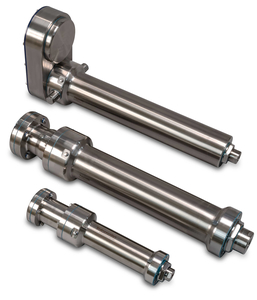

|
Edward Lowton
Editor |


|
| Home> | Plant, Process & Control | >Process equipment | >Optimising actuator hygienic design |
| Home> | Plant, Process & Control | >Seals and sealants | >Optimising actuator hygienic design |
Optimising actuator hygienic design
28 July 2022
Food and beverage manufacturers are requiring cleaner, safer machine designs from their OEM machine builders, explains INMOCO's Gerard Bush

AS THE linear mover in many production applications, it's crucial that actuators are designed to ensure optimum hygiene, preventing the build-up of bacteria with the ability to withstand aggressive washdowns. When specifying an electric actuator, it's also vital that they ensure lasting use without the need for extensive, time consuming maintenance.
Within food and beverage production, when linear motion is required, actuators are commonly present. As such, linear actuators are used in applications from packaging to handling the product itself, with processes such as forming, cutting, and slicing.
The trend from food and beverage manufacturers to increasingly require cleaner, safer designs from their OEM machine builders, particularly within higher-risk processing environments, such as meat, cheese, dairy, seafood and poultry, is in turn pushing this demand to machine component manufacturers. For actuator designs, this means they must be optimised for hygienic use, while ensuring accurate performance, reliability, and long-life.
The design entry benchmark is to ensure legal compliance. Depending on geographical markets and end use, typically this will include adherence to the European Hygienic Engineering Design Group (EHEDG), as well as the 3A sanitary standards that represent the United States Department of Agriculture (USDA) and the Food & Drug Administration (FDA).
However, before looking at the specifics of actuator design, the first consideration is how the actuator should integrate with the wider machine in order to optimise hygiene. Open-frame machine architecture enables optimisation of the clean in place (CIP) principles, ensuring visibility for effective cleaning, as well as the ability to clean all required areas, in particular those in contact with or proximity to the product.
Coinciding with open machine design, the actuator requires stainless steel construction, with 316 stainless steel considered ‘food grade’ for its qualities in resistance to corrosion. Actuators such as Tolomatic’s RSH design can withstand regular washdown with aggressive chemicals without developing corrosion blemishes that could harbour bacteria. In addition, the design form must avoid crevices and sharper angles that can accumulate bacteria and debris. Instead, rounded edges prevent food particles from collecting and pooling, while sanitary solutions can easily drain away after washdown.
Minimising downtime with the right seals
Combined with stainless steel construction, robust seals are required to ensure that an actuator achieves an IP69K rating, signifying protection against dust and water ingress, including high pressure water jets used during washdown. Surrounding the actuator's thrust rod, seals prevent ingress that would otherwise cause corrosion and harbour bacteria. In order to minimise maintenance downtime and ensure actuator long-life, seals must also be durable to withstand washdown conditions.
Polyurethane seals are suitable for most applications, with high tolerance of abrasives like salt and sugar, but for use with the most abrasive caustic chemicals, polyurethane with UHMWPE should be used. For ease of maintenance, a cartridge design, like that used on Tolomatic’s RSH actuator, enables quick seal replacement without the need for specialized tools, while its dual seal system increases protection.
To ensure effective operation and long life, an actuator for use in food and beverage applications also has to be able to withstand varying temperatures. Dealing with potentially freezing conditions through to high extremes, a versatile actuator for food & beverage production should be able to cope with a range spanning from -10° through to 40C°.
Whether to opt for an integrated motor
Additionally, an important design consideration is whether to integrate the motor or use a more traditional approach with a separate device. The advantage of an integrated system is a sealed unit, reducing potential points of ingress and with fewer points for bacteria collection. This design also increases the unit's protection, reducing maintenance requirements and increasing actuator longevity.
Following machine design and eventual installation, attention to appropriate ongoing maintenance should also be undertaken in order to maintain optimum hygiene and long-lasting operation. Typically, actuators are lubricated at the factory, ready for installation. However, the internal screw will require re-lubrication at pre-determined intervals. Actuators with grease ports, such as Tolomatic’s stainless steel designs, help ensure optimum operating condition by allowing fast and simple lubrication without disassembly or the need for special tools.
For additional support on machine design and ongoing care, including actuators and motion control devices for hygienic food and beverage applications, INMOCO's engineers have extensive experience supporting OEM designers achieve the requirements. While the demands of the food and beverage manufacturers continue to increase, by carefully following hygienic design principles, the value that machine builders provide can rise to the challenge with careful component specification.
- Improving railway rolling-stock maintenance
- London and the South East an emerging industrial powerhouse
- Industry lows & highs
- IP&E reports from Maintec 2019
- How to outsource manufacturing effectively
- Cyber attack on steel mill causes physical damage
- Smart factory investment at critical stage
- Robots could take 20 million jobs by 2030
- Safety stars sought
- National eye health week: Employers urged to take action


















